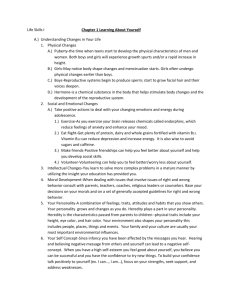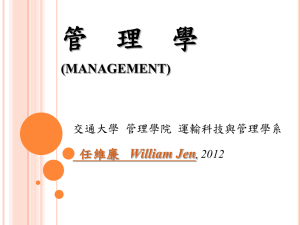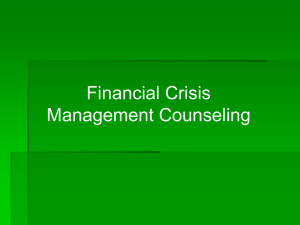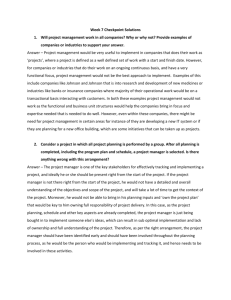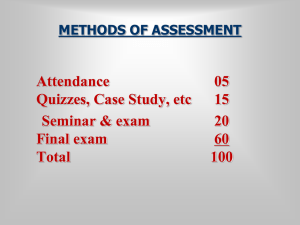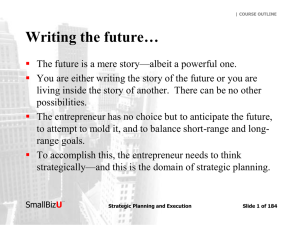Chapter 1
advertisement
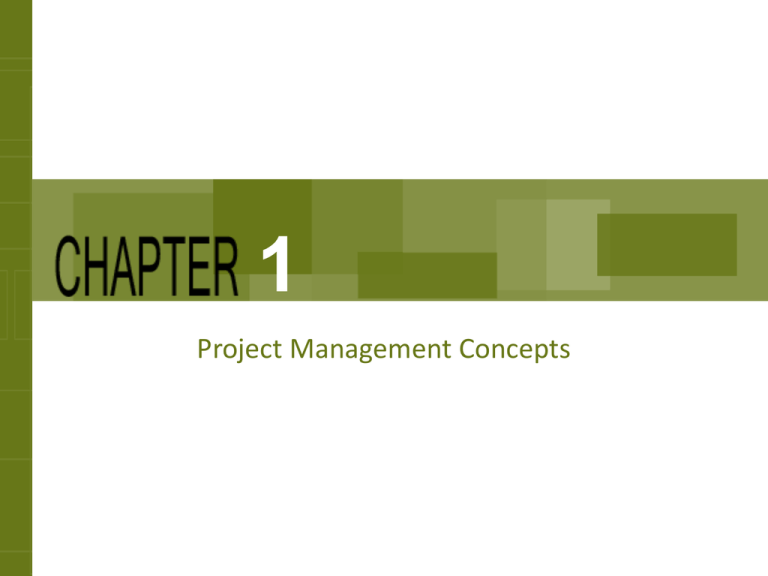
1 Project Management Concepts Chapter Concepts Definition of a project and its attributes Key constraints within which a project must be managed Life cycle of a project Definition of project management Elements of the project management process Implications of global project management Project Management Institute Benefits of project management Learning Outcomes Define what a project is List and discuss the attributes of a project Explain what is meant by project objective Define what is meant by project deliverable Provide examples of projects Discuss project constraints Describe the phases of the project life cycle Define and apply project management Discuss the steps of the planning process Identify the three elements of the executing process Discuss some implications of global project management Discuss the Project Management Institute List benefits of project management techniques Project Management Knowledge Areas from PMBOK® Guide Project Integration Management Feds and Contractor Share Blame for Afghan Power Plant Delays Background Initial plant costs $125 million Similar plants cost $105 million Scope and budget changes drove estimated cost to $260 million Planned completion date delayed more than a year 15 Modifications and issues Final cost ~ $300 million Contractor had cost-plus contract Subcontractors had fixed price contracts Outcomes The plant may not be used Operation costs three times similar plants Mistakes were made Not pay attention to lessons learned Failure related to needs, resources, risks, and schedules Lack of critical project management components Planners ignored local officials' alternative recommendations Causal Inferences on the Cost Overruns and Schedule Delays of Large-Scale U.S. Federal Defense and Intelligence Acquisition Programs - Per 2008 GAO report on 95 weapon systems - Total overruns: $295B Avg delay: 21 months Causes for Delays Failures to translate customer needs into specific capabilities Incorrect commercial products selected Delays cost $12 million a week in personnel costs Non-existent succession planning for new PMs Solutions Communication with stakeholders Mentoring of junior project personnel Adoption and execution of project management skills and techniques Project, Defined A project is: an endeavor to accomplish a specific objective through a unique set of interrelated tasks and the effective utilization of resources. 5 Project Attributes Clear objective Series of interdependent tasks Various resources Specific time frame May be a unique, one-time endeavor Sponsor or customer Degree of uncertainty Balancing Project Constraints Project Manager Actions Prevent, anticipate, overcome Have good planning and communication Be responsible The Project Life Cycle Projects are “born” when a need is identified by the customer. Project life cycles vary in length, from a few weeks to several years. Not all projects formally go through all four phases of the project life cycle. 10 The Project Life Cycle Initiating Phase Identify need, problem, or opportunity Possibly do project selection Develop project charter Rationale Project objective Expected benefits General requirements and conditions Decide if RFP needed § § Proposal Evaluation Sign contract Planning Phase How to accomplish scope Plan the work and work the plan Develop baseline plan What -- scope, deliverable How -- activities, sequence Who -- resources, responsibilities How long -- durations, schedule How much -- budget Risks Have actual resources plan the work Performing Phase Accomplish project objectives Project manager leads Project team completes the project Increase pace as more resources are added Monitor and control progress Take corrective action as needed Manage and control changes with sponsor approval Achieve customer satisfaction with acceptance of deliverable Closing Phase Collect and make final payments Recognize and evaluate staff Conduct post project evaluation Document lessons learned Archive project documents Record lessons learned Project Planning Process Establish project objective Define scope Create WBS Assign responsibility Define specific activities Sequence activities Estimate activity resources Estimate activity durations Develop project schedule Estimate activity costs Determine budget RESULT: BASELINE PLAN Create WBS and Assign Responsibility Sequence Activities Develop the Project Schedule Determine Budget Execute the Project Plan Perform the work Monitor and control progress Control changes Global Project Management Globalization Adds a dimension of complexity Changes project dynamics Requires awareness of factors Cultural differences Currency Codes and regulations Business organization Political relations Workforce availability Helpful Competencies Foreign language skills Knowledge of Cultures Geography World history and contemporary events International economics Awareness of Customs and etiquette Geopolitical environment Technology adoption and translation software Project Management Associations Project Management Institute Worldwide not-for-profit association of practitioners 350,000 members in >170 countries 250 chapters in >70 countries Online communities for collaboration PMBOK® Guide PMI Code of Ethics and Professional Conduct Certifications www.pmi.org Global Associations Links available at www.cengagebrain.com Critical Success Factors Planning and communication are critical to successful project management. They prevent problems from occurring or minimize their impact on the achievement of the project objective when they do occur. Taking the time to develop a well thought-out plan before the start of the project is critical to the successful accomplishment of any project. A project must have a clear objective of what is to be accomplished and defined in terms of end product or deliverable, schedule, and budget; and is agreed upon by the customer. Involve the sponsor or customer as a partner in the successful outcome of the project through active participation during the project. Achieving customer satisfaction requires ongoing communication with the customer to keep the customer informed and to determine whether expectations have changed. The key to effective project control is measuring actual progress and comparing it to planned progress on a timely and regular basis and taking any needed corrective action immediately. After the conclusion of a project, the project performance should be evaluated to learn what could be improved if a similar project were to be undertaken in the future. Feedback should be obtained from the sponsor or customer and the project team. Learning and understanding the culture and customs of other project participants will demonstrate respect, help build trust, and aid in developing an effective project team; and it is critical for successful global project management. Summary A project is an endeavor to accomplish a specific objective through a unique set of interrelated tasks and the effective utilization of resources. The successful accomplishment of the project objective could be constrained by many factors, including scope, quality, schedule, budget, resources, risks, and customer satisfaction. The project life cycle has four phases: initiating, planning, performing, and closing the project. Project management is planning, organizing, coordinating, leading, and controlling resources to accomplish the project objective. The project management process involves two major functions: first establishing a plan and then executing that plan to accomplish the project objective. Globalization changes the dynamics of a project and adds a layer of complexity that can adversely affect the project outcome if the project participants are not aware of what they can encounter regarding cultural differences and multinational economic transactions. The Project Management Institute is a premier worldwide not-for-profit association for practitioners in the project management profession. The ultimate benefit of implementing project management techniques is having a satisfied customer—whether you are the customer of your own project or a business (contractor) being paid by a customer to perform a project. Benefits of Project Management Satisfied customers Additional business Expansion of career opportunities Satisfaction of being on a winning team Improved knowledge and skills When projects are successful, everybody WINS 20

